A little history
Nineteen seventy was a terrible year for McLaren. True, the team renewed its traditional success in the CanAm championship, but not only it ended the F1 season without a single win, which had never happened since the team’s burgeoning, it above all lost its founder Bruce McLaren, killed in a practice crash in June. Thereafter Teddy Mayer led the team, while the faithful Denny Hulme remained as number one driver.
The first task for 1971 was to replace the disappointing M14 by a brand new design. McLaren’s chief designer Gordon Coppuck electing to concentrate on Indycars, the work entirely rested upon his assistant Ralph Bellamy, who produced the M19A, a rather conventional single-seater powered by the ubiquitous Ford-Cosworth V8 engine. Its only original trait resided in its advanced suspension system. Structure was monocoque, built in aluminium, and hidden under a fibreglass body. Fully stressed, the exposed engine was an integral part of this structure.
The 1971 season seemed to start well for the M19A. At Kyalami for the South African opener, the car was indeed fast. With four laps to go, Denny Hulme was ahead of the field – then disaster struck as his exhausted machine refused to do more than coast to the finishing line. Though this could have looked promising, the car had already shown its limits as the behaviour of its “revolutionary” suspension had proved rather unpredictable during the whole event. The entire season would reflect this dual character: the M19A was swift, but fragile. Continuously tuning the suspension or adding a new nose or airbox didn’t help. Much blame was put on the team’s number two driver, Peter Gethin, who got the boot after the German Grand Prix. Two races later, the Brit won an epic Italian Grand Prix at the wheel of a second fiddle, the BRM – the first McLaren was seventh during the very same event, a clear demonstration that, after all, the M19A alone was the cause of McLaren’s misfortunes… Best result of the season finally came from a privately-entered M19A, when Mark Donohue placed third at the Canadian GP with a Roger Penske / Kirk F. White car. No more than ten points were earned during the year, the worst result since the team participated to the full F1 season.
In 1972, the M19A rapidly gave way to the M19C. The troublesome suspension arrangement was a thing of the past, and the car was now conventional all-around, but what had been lost in originality was largely compensated by increased reliability. Gone too were the last remnants of the southern hemisphere origins of the team, as the traditional orange livery and team logo were replaced by the colours of its new sponsor, Yardley. Now seconded by Peter Revson, Denny Hulme took a great start, finishing second in the new Argentinean GP, then taking his revenge in South Africa, the team’s first victory since 1969. This remained a lone success, but McLaren was regularly on the podium that year. Finally, the M19C opened the 1973 season before retiring in favour of the new M23, which was to become one of the most important Formula One cars McLaren ever built. Refitted with a Chevrolet V8, the M19 ended its career as a F5000 racer.
About the model
Model: McLaren M19A - Ford Cosworth
Event: 1971 Canadian Grand Prix, driven by Mark Donohue (finished 3rd overall)
Maker: Minichamps, “McLaren Collection” ref. 48
Scale: 1/43
Distributed by: Minichamps, limited edition
Acquired: brand new, in May 2006, in Manila, Philippines
A nice Minichamps model. The works cars look nice, but I instead settled for the great Sunoco livery of Donohue’s M19. My rating is 15/20.
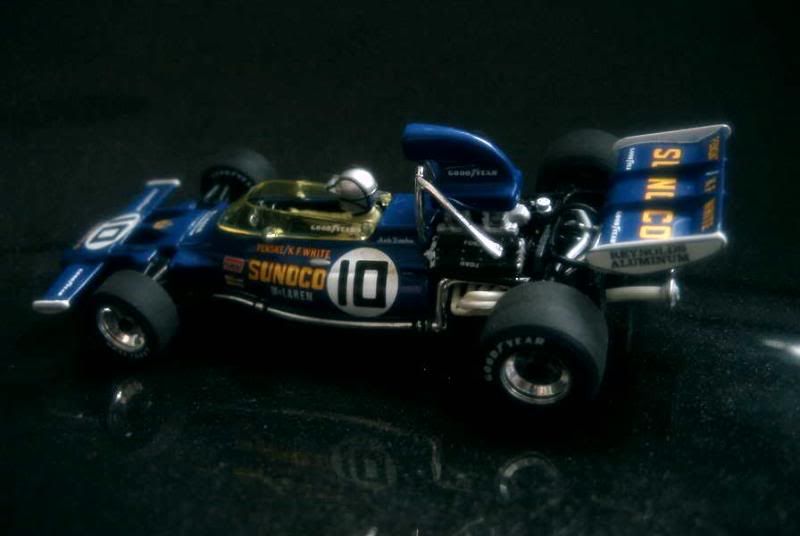
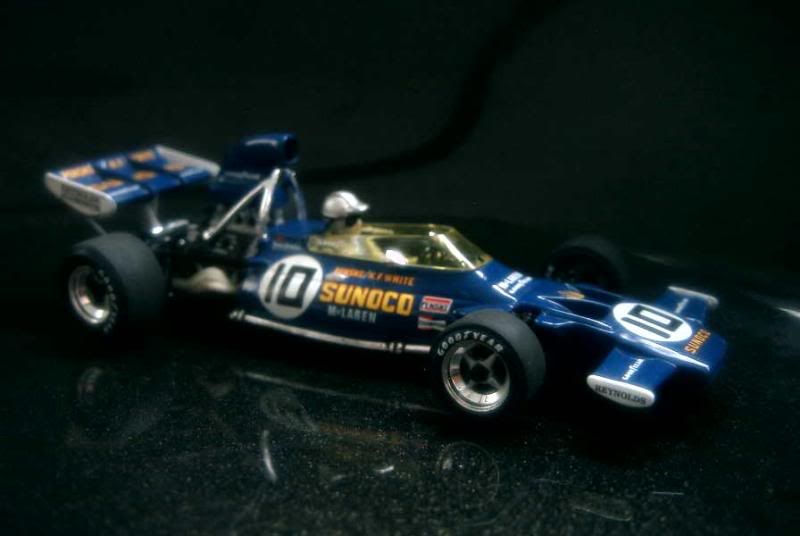
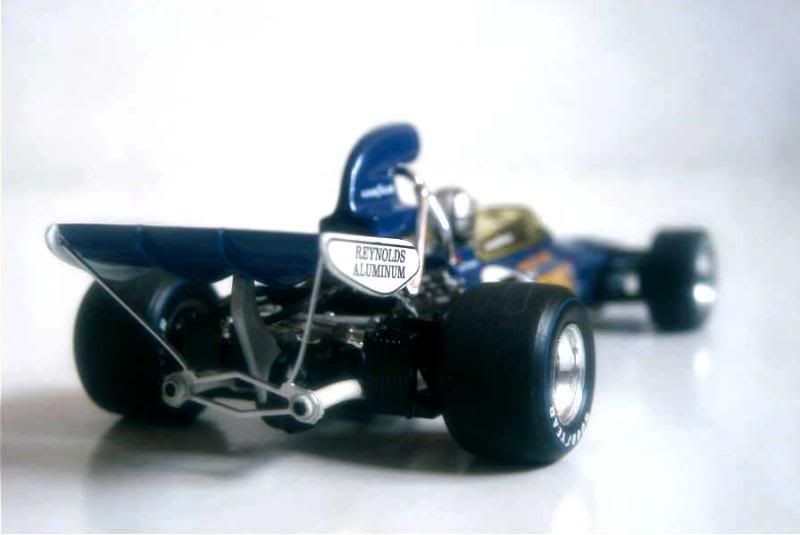
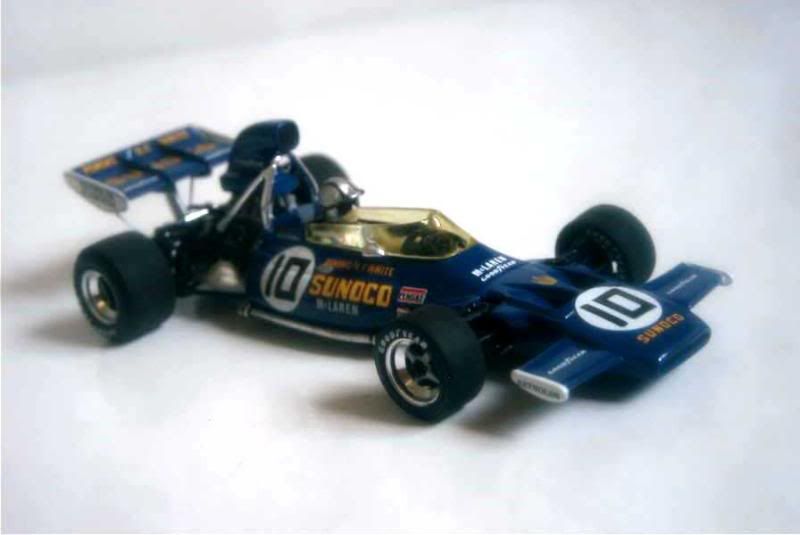
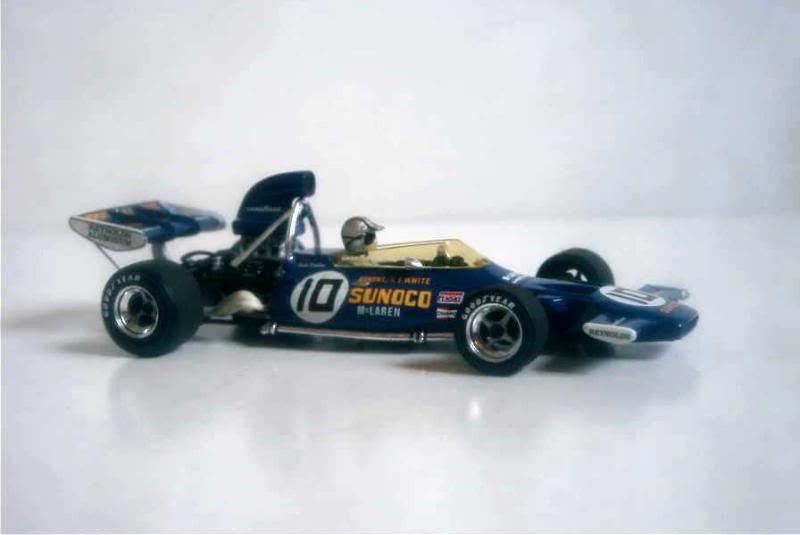
Nineteen seventy was a terrible year for McLaren. True, the team renewed its traditional success in the CanAm championship, but not only it ended the F1 season without a single win, which had never happened since the team’s burgeoning, it above all lost its founder Bruce McLaren, killed in a practice crash in June. Thereafter Teddy Mayer led the team, while the faithful Denny Hulme remained as number one driver.
The first task for 1971 was to replace the disappointing M14 by a brand new design. McLaren’s chief designer Gordon Coppuck electing to concentrate on Indycars, the work entirely rested upon his assistant Ralph Bellamy, who produced the M19A, a rather conventional single-seater powered by the ubiquitous Ford-Cosworth V8 engine. Its only original trait resided in its advanced suspension system. Structure was monocoque, built in aluminium, and hidden under a fibreglass body. Fully stressed, the exposed engine was an integral part of this structure.
The 1971 season seemed to start well for the M19A. At Kyalami for the South African opener, the car was indeed fast. With four laps to go, Denny Hulme was ahead of the field – then disaster struck as his exhausted machine refused to do more than coast to the finishing line. Though this could have looked promising, the car had already shown its limits as the behaviour of its “revolutionary” suspension had proved rather unpredictable during the whole event. The entire season would reflect this dual character: the M19A was swift, but fragile. Continuously tuning the suspension or adding a new nose or airbox didn’t help. Much blame was put on the team’s number two driver, Peter Gethin, who got the boot after the German Grand Prix. Two races later, the Brit won an epic Italian Grand Prix at the wheel of a second fiddle, the BRM – the first McLaren was seventh during the very same event, a clear demonstration that, after all, the M19A alone was the cause of McLaren’s misfortunes… Best result of the season finally came from a privately-entered M19A, when Mark Donohue placed third at the Canadian GP with a Roger Penske / Kirk F. White car. No more than ten points were earned during the year, the worst result since the team participated to the full F1 season.
In 1972, the M19A rapidly gave way to the M19C. The troublesome suspension arrangement was a thing of the past, and the car was now conventional all-around, but what had been lost in originality was largely compensated by increased reliability. Gone too were the last remnants of the southern hemisphere origins of the team, as the traditional orange livery and team logo were replaced by the colours of its new sponsor, Yardley. Now seconded by Peter Revson, Denny Hulme took a great start, finishing second in the new Argentinean GP, then taking his revenge in South Africa, the team’s first victory since 1969. This remained a lone success, but McLaren was regularly on the podium that year. Finally, the M19C opened the 1973 season before retiring in favour of the new M23, which was to become one of the most important Formula One cars McLaren ever built. Refitted with a Chevrolet V8, the M19 ended its career as a F5000 racer.
About the model
Model: McLaren M19A - Ford Cosworth
Event: 1971 Canadian Grand Prix, driven by Mark Donohue (finished 3rd overall)
Maker: Minichamps, “McLaren Collection” ref. 48
Scale: 1/43
Distributed by: Minichamps, limited edition
Acquired: brand new, in May 2006, in Manila, Philippines
A nice Minichamps model. The works cars look nice, but I instead settled for the great Sunoco livery of Donohue’s M19. My rating is 15/20.








6 comments:
Hi, Lorenzo:
It´s a fantastic model. I´ve got the Porsche 917/30 Sunoco driven by Donohue, too...but the quality is worst than this model.
Hi Manuel!
Yes I know what model you're talking about, I have it too! Yes it's not a great model, but it's not so bad either: I posted some pictures of it some years ago on a forum and a collector of CanAm die-casts confused it for a much more expensive model. May this little anecdote make you change your point of view! ;)
Regards,
Lorenzo.
Excelent! Very good model...
I'm green with envy!
Congrats
José
Thanks José António!
¡Espectacular M19A!
Es una joya para cualquier vitrina.
Abrazos!
http://juanhracingteam.blogspot.com/
Hi Juan,
True, really a nicely made model!
Regards,
Lorenzo.
Post a Comment